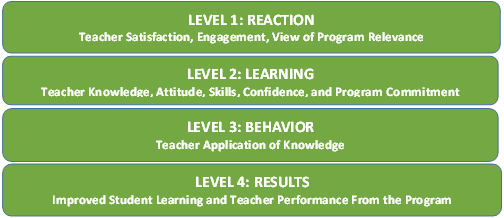Creating an Objectives-Driven PD Program in ELT
by Autumn Westphal
 One of the greatest challenges I had to face as one of the program directors at a small private English as a second language school was how to provide an enriching professional development (PD) program that not only met the needs of the faculty and students but also the needs of the school—as an educational institution and a business. We, as a school, had always offered PD to our teachers. At any given time, we had 20–30 teachers working in the school in our various programs (General English, Business and Professional English, as well as our Teens Program), and we offered them professional development workshops (PDWs) as well as a biannual TESOL mini-conference. However, we realized that what we were offering was not working: We had very little buy-in from the faculty, attendance of workshops was at an all-time low, and we had no systems in place to monitor and track whether the PD we offered was actually improving the school in any way.
One of the greatest challenges I had to face as one of the program directors at a small private English as a second language school was how to provide an enriching professional development (PD) program that not only met the needs of the faculty and students but also the needs of the school—as an educational institution and a business. We, as a school, had always offered PD to our teachers. At any given time, we had 20–30 teachers working in the school in our various programs (General English, Business and Professional English, as well as our Teens Program), and we offered them professional development workshops (PDWs) as well as a biannual TESOL mini-conference. However, we realized that what we were offering was not working: We had very little buy-in from the faculty, attendance of workshops was at an all-time low, and we had no systems in place to monitor and track whether the PD we offered was actually improving the school in any way.
So, my school director, my academic team, and I embarked on a quest to revitalize our PD program and set up a system of checks and balances to ensure that what we were offering was effective and goals-driven, and that it was evaluated based on student and teacher feedback. In this article, I outline the basic steps we used to relaunch our PD program and create the systems we needed to ensure that our program would continue to grow and improve over time.
Step 1: Guidelines, Goals, and Assessment
Before we started thinking about the actual content of the program, my team and I realized that we needed a foundation to build from—in the end, what did we want our new PD program to be like? What did we want it to include? We came up with these five guidelines:
- Teachers and administrator will be accountable—they will have roles to fulfill and responsibilities to complete as active members of the program.
- The program needs to have goals that can be measured and evaluated.
- The program needs to include input from teachers, staff, and students.
- The program needs to include a variety of PD options.
- The program needs to be reviewed regularly (at least annually).
From these guidelines, we then came up with our program goals. As we created the goals, we had to consider how we would evaluate and assess the program. One of our greatest inspirations through the goal-creation process was the Kirkpatrick Model (Kirkpatrick, Kirkpatrick, & Kirkpatrick, 2018) which breaks down the evaluation of training into four levels:

Considering these four levels, we were able to come up with goals that were then directly connected to sources of evaluation.
Goal 1
Improve teaching practices resulting in greater student satisfaction and improved learning outcomes.
Assessment and Evaluation: Annual collection and analysis of student feedback and an evaluation of satisfactory academic progress of students for the calendar year (Level 4: Results).
Goal 2
Ensure consistency in the quality of teaching as measured by alignment with our institution’s approach to teaching and current English language teaching methodology.
Assessment and Evaluation: Annual analysis of teacher observation reports (Level 3: Behavior).
Goal 3
Empower teachers to take ownership of their personal PD and transform teachers who are reticent about PD into engaged participants.
Assessment and Evaluation: Annual satisfaction survey of the teachers, analysis of feedback forms collected after each PD offering, and analysis of annual PD participation (Level 1: Reaction and Level 2: Learning).
Step 2: Needs Analysis and Program Content
Now that we had our goals, assessment, and evaluation planned out, we decided to do a comprehensive teacher needs analysis survey before outlining the program content and implementation. Because we had an existing PD program, we structured the needs analysis survey to first evaluate the effectiveness of the current program and then to identify the needs of the new program.
To come up with the questions for the survey, we allowed the descriptions of Kirkpatrick’s (Kirkpatrick et al., 2018) Levels 1 (Teacher Satisfaction, Engagement, View of Program Relevance) and 2 (Teacher Knowledge, Attitude, Skills, Confidence, and Program Commitment) to guide us. This allowed us to pinpoint questions on confidence (What can we do to help you feel more confident implementing new teaching ideas in your classroom?) and engagement (What kind of PD offerings are most engaging to you?) that we had never thought to ask about before.
We also made sure include a list of PD offerings that teachers could rate in terms of relevance and interest. We wanted to present diverse options to meet the needs of both stronger and weaker teachers as well as both newer and more experienced teachers. We often talk about differentiating instruction for our students, but we had never thought of applying concept this to our teachers, too! Here is the list we came up with (teachers also had the option of filling in their own ideas):
- PDWs (offered at least once a month)
- Supervisor observations
- Peer observations
- Leading or coleading a professional development workshop
- Attending off-site PD (local conference, workshop, lecture, etc.)
- Attending a webinar
- Peer-to-peer training or teacher shadowing for specific class types (e.g., if a teacher would like to be trained specifically to teach a test preparation course or Business English)
- Coteaching/team teaching
- Academic project (proposal for presentation at a conference, action research, writing an article, etc.)
After administering the survey, we were surprised and heartened to discover that not only did our teachers strongly desire to take part in PD, but they also wanted to participate in a variety of PD options, including more peer-based training. Prior to this survey, we had never imagined that the teachers would be so interested in having the school provide structured opportunities for them to share ideas and learn from each other. We had assumed they would do this on their own time. With our needs analysis survey data, we were then ready to structure the program based on the teacher’s wants and needs.
Step 3: Policies and Procedures
The final step before launching the program was to outline the policies (for the faculty handbook) and the procedures of how the program would work. We broke this down into three areas:
-
Content and Participation: the policies that outlined the PD content and the PD participation requirements for the teachers.
-
Implementation: the procedures that laid out how different PD options would be offered, what teachers needed to do to participate in the PD, and how teachers could gain credit for taking part in the PD.
-
Evaluation and Assessment: the procedures outlining how feedback would be collected (in what form and how often) and compiled for the program annually as well as for each specific PD option (e.g., professional development workshops, peer observations, webinars), the policies describing the benchmarks we needed to reach to successfully meet our goals for the PD program, and the procedures describing how the evaluation of feedback would led to the adaptation and improvement of the program for the following year.
The content of the policies and procedures will be unique to each institution that is hosting a PD program. Therefore, I think it is a good idea to stop here. Keep in mind that this is the most detail-oriented and arduous of the three steps presented—and often the most overlooked. A program filled with great content that is based on teacher and student needs will fall flat if there are no systems in place to outline how the program should run. So, take the time needed to fully detail how everything will work. Then, the likelihood of the program succeeding out of the starting gate will increase tenfold.
In our experience with this process, we realized that a PD program without goals and assessment is like a house built on the sand—you can live in it, but you won’t be able to build on it. By involving the teachers and the students in the creation and assessment of the PD program, we discovered that PD with a purpose creates an environment of growth and learning that does so much more than meet a requirement for accreditation—it builds a better school and a better school community. If you are interested in reading more about the work we did on our PD program, you can download the presentation PowerPoint (PDF), presented at the 2018 TESOL Convention.
Acknowledgement: This article is based on my session from the 2018 TESOL International Convention titled “Implementing an Objectives-Driven, Results-Oriented, Sustainable Professional Development Program,” which was created in partnership with my colleague James Stakenburg. I would also like to thank the other members of the academic team who helped outline and create the PD program described in this article: Terence Helsel, Sunyu Park, and Alex Anderson.
Reference
Kirkpatrick, D. L., Kirkpatrick, J. D., & Kirkpatrick, W. K. (2018, January). The Kirkpatrick model. Retrieved from https://www.kirkpatrickpartners.com/Our-Philosophy/The-Kirkpatrick-Model
Autumn Westphal has been working in the English to speakers of other languages field since 2006. She has worked as a language teacher, teacher trainer, curriculum developer, and program director. She has presented on teacher training and PD at numerous conferences, including NYS TESOL, the TESOL International Convention, and IATEFL. She currently works for Pearson English as content developer.